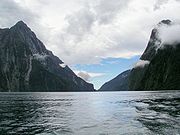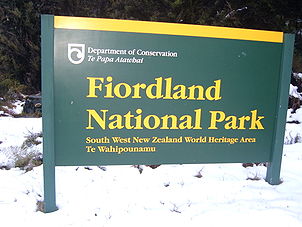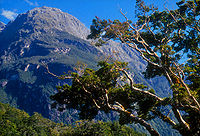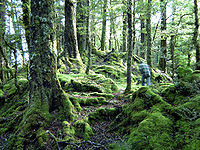
Fiordland National Park
Encyclopedia
Fiordland
National Park occupies the southwest corner of the South Island of New Zealand
. It is the largest of the 14 national parks in New Zealand, with an area of 12,500 km², and a major part of the Te Wahipounamu
World Heritage site
. The park is administered by the Department of Conservation
.





 During the cooler past, glaciers carved many deep fiords
During the cooler past, glaciers carved many deep fiords
, the most famous (and most visited) of which is Milford Sound
. Other notable fiords include Doubtful Sound
and Dusky Sound
. From one of the peaks within Fiordland National Park, a view of Mount Aspiring/Tititea to the far north can be observed.
Fiordland's coast is steep and crenellated, with the fiords running from the valleys of the southern ranges of the Southern Alps
, such as the Kepler and Murchison Mountains. At the northern end of the park, several peaks rise to over 2,000 metres.
Ice has carved islands from the mainland, leaving two large uninhabited offshore islands, Secretary Island
and Resolution Island
. Several large lakes lie wholly or partly within the park's boundaries, notably Lake Te Anau
, Lake Manapouri
, Lake Monowai
, Lake Hauroko
, and Lake Poteriteri
.
The Sutherland Falls
, to the southwest of Milford Sound on the Milford Track, are among the world's highest waterfall
s.
Prevailing westerly winds blow moist air from the Tasman Sea
onto the mountains; the cooling of this air as it rises produces a prodigious amount of rainfall, exceeding seven metres in many parts of the park. This supports the lush temperate rain forests of the Fiordland temperate forests ecoregion
.
, the only flightless parrot in the world. Also there is the kiwi
, which is native to New Zealand. The Park is heavily forested with Nothofagus
trees, a large variety of understory shrubs and fern
s being present; examples of the forest floor vegetation include Crown Fern, Blechnum discolor
.
, skirting the edge of the park before entering it close to the headwaters of the Eglinton River
. From there it crosses the northwest corner of the park, reaching its terminus at Milford Sound. South of Te Anau a smaller road links to Manapouri
. A minor road links Doubtful Sound with the western edge of Lake Manapouri via the Wilmot Pass
.
Light aircraft and helicopter services link with Milford Sound, which also has a small boat marina
.
and especially for trampers, with the Milford
, Kepler
, Hollyford
and Routeburn Track
s all in or close to the park.
Fiordland is a challenging tramping destination. There are few tracks. Off-track travel relies on following deer trails. Sandflies, flooding and poor weather are a hazard.
Other tourists
are attracted to areas such as Milford Sound
.
During the early 1960s, an international market for wild venison was established, and with no restrictions on hunting, market hunters established themselves in the rugged park country and used pack horses, jetboats and fixed wing aircraft to get the carcasses out to market. Experiments with shooting wild deer from helicopters were highly successful and a competitive industry was based on this technique. By the late 1970s, the deer population in Fiordland had been severely reduced, and combined with a flourishing deer farming industry this has reduced the impact of aerial hunting over the National Park.
Market hunting from helicopters continues today in a reduced fashion, with the largest market being Germany. The NZ government uses helicopters to poison the deer and possum population with aerial dropping of large volumes of 1080 poison, despite some public opposition to the indiscriminate use of such poisons.
Fiordland
Fiordland is a geographic region of New Zealand that is situated on the south-western corner of the South Island, comprising the western-most third of Southland. Most of Fiordland is dominated by the steep sides of the snow-capped Southern Alps, deep lakes and its ocean-flooded, steep western valleys...
National Park occupies the southwest corner of the South Island of New Zealand
New Zealand
New Zealand is an island country in the south-western Pacific Ocean comprising two main landmasses and numerous smaller islands. The country is situated some east of Australia across the Tasman Sea, and roughly south of the Pacific island nations of New Caledonia, Fiji, and Tonga...
. It is the largest of the 14 national parks in New Zealand, with an area of 12,500 km², and a major part of the Te Wahipounamu
Te Wahipounamu
Te Wāhipounamu is a World Heritage site in the south west corner of the South Island of New Zealand.Inscribed on the World Heritage List in 1990 and covering 26,000 km², the site incorporates several National Parks:...
World Heritage site
World Heritage Site
A UNESCO World Heritage Site is a place that is listed by the UNESCO as of special cultural or physical significance...
. The park is administered by the Department of Conservation
New Zealand Department of Conservation
The Department of Conservation , commonly known by its acronym, "DOC", is the state sector organisation which deals with the conservation of New Zealand’s natural and historic heritage...
.
Geographical features






Fjord
Geologically, a fjord is a long, narrow inlet with steep sides or cliffs, created in a valley carved by glacial activity.-Formation:A fjord is formed when a glacier cuts a U-shaped valley by abrasion of the surrounding bedrock. Glacial melting is accompanied by rebound of Earth's crust as the ice...
, the most famous (and most visited) of which is Milford Sound
Milford Sound
Milford Sound is a fjord in the south west of New Zealand's South Island, within Fiordland National Park, Piopiotahi Marine Reserve, and the Te Wahipounamu World Heritage site...
. Other notable fiords include Doubtful Sound
Doubtful Sound
Doubtful Sound is a very large and naturally imposing fjord in Fiordland, in the far south west of New Zealand. It is located in the same region as the smaller but more famous and accessible Milford Sound...
and Dusky Sound
Dusky Sound
Dusky Sound is a fiord on the south west corner of New Zealand, in Fiordland National Park.-Geography:One of the most complex of the many fjords on this coast, it is also one of the largest, 40 kilometres in length and eight kilometres wide at its widest point...
. From one of the peaks within Fiordland National Park, a view of Mount Aspiring/Tititea to the far north can be observed.
Fiordland's coast is steep and crenellated, with the fiords running from the valleys of the southern ranges of the Southern Alps
Southern Alps
The Southern Alps is a mountain range extending along much of the length of New Zealand's South Island, reaching its greatest elevations near the island's western side...
, such as the Kepler and Murchison Mountains. At the northern end of the park, several peaks rise to over 2,000 metres.
Ice has carved islands from the mainland, leaving two large uninhabited offshore islands, Secretary Island
Secretary Island
Secretary Island is an island in southwestern New Zealand, lying entirely within Fiordland National Park. Roughly triangular in shape, it lies between Doubtful Sound in the south and Thompson Sound in the north, with its west coast facing the Tasman Sea. Steeply sloped, it rises to nearly...
and Resolution Island
Resolution Island, New Zealand
Resolution Island is the largest island in Fiordland region of southwest New Zealand, covering a total of . It is the country's seventh largest island...
. Several large lakes lie wholly or partly within the park's boundaries, notably Lake Te Anau
Lake Te Anau
Lake Te Anau is in the southwestern corner of the South Island of New Zealand. Its name was originally Te Ana-au, Maori for 'The cave of swirling water'. The lake covers an area of 344 km², making it the second-largest lake by surface area in New Zealand and the largest in the South Island...
, Lake Manapouri
Lake Manapouri
Lake Manapouri is a lake in the South Island of New Zealand. Its name is Maori for "sorrowful heart", though this name is misapplied due to an early cartographical error...
, Lake Monowai
Lake Monowai
Lake Monowai is a large lake in the southern part of Fiordland National Park, in New Zealand's South Island, 120 kilometres northwest of Invercargill. At an altitude of 180 metres in a long curved valley, the lake appears on maps shaped like a letter "U". The western part of the lake is set in...
, Lake Hauroko
Lake Hauroko
Lake Hauroko is located in a mountain valley in Fiordland National Park in the South Island of New Zealand. The long S-shaped lake is 30 kilometres in length and covers an area of 63 km². The surface is at an altitude of 150 metres above sea level, and the lake is 463 metres deep...
, and Lake Poteriteri
Lake Poteriteri
Lake Poteriteri is the southernmost of the large lakes in Fiordland National Park in New Zealand's South Island. Only Lakes Hakapoua and Innes lie further south on the southern of New Zealand's two main islands...
.
The Sutherland Falls
Sutherland Falls
Sutherland Falls is a waterfall near Milford Sound in New Zealand's South Island. At 580 metres the falls were long believed to be the tallest waterfall in New Zealand...
, to the southwest of Milford Sound on the Milford Track, are among the world's highest waterfall
Waterfall
A waterfall is a place where flowing water rapidly drops in elevation as it flows over a steep region or a cliff.-Formation:Waterfalls are commonly formed when a river is young. At these times the channel is often narrow and deep. When the river courses over resistant bedrock, erosion happens...
s.
Prevailing westerly winds blow moist air from the Tasman Sea
Tasman Sea
The Tasman Sea is the large body of water between Australia and New Zealand, approximately across. It extends 2,800 km from north to south. It is a south-western segment of the South Pacific Ocean. The sea was named after the Dutch explorer Abel Janszoon Tasman, the first recorded European...
onto the mountains; the cooling of this air as it rises produces a prodigious amount of rainfall, exceeding seven metres in many parts of the park. This supports the lush temperate rain forests of the Fiordland temperate forests ecoregion
Ecoregion
An ecoregion , sometimes called a bioregion, is an ecologically and geographically defined area that is smaller than an ecozone and larger than an ecosystem. Ecoregions cover relatively large areas of land or water, and contain characteristic, geographically distinct assemblages of natural...
.
Vegetation and Wildlife
The wildlife in this area include dolphins, seals and birds. Introduced species include mice, rats, hare and deer. Among the birds are the KakapoKakapo
The Kakapo , Strigops habroptila , also called owl parrot, is a species of large, flightless nocturnal parrot endemic to New Zealand...
, the only flightless parrot in the world. Also there is the kiwi
Kiwi
Kiwi are flightless birds endemic to New Zealand, in the genus Apteryx and family Apterygidae.At around the size of a domestic chicken, kiwi are by far the smallest living ratites and lay the largest egg in relation to their body size of any species of bird in the world...
, which is native to New Zealand. The Park is heavily forested with Nothofagus
Nothofagus
Nothofagus, also known as the southern beeches, is a genus of 35 species of trees and shrubs native to the temperate oceanic to tropical Southern Hemisphere in southern South America and Australasia...
trees, a large variety of understory shrubs and fern
Fern
A fern is any one of a group of about 12,000 species of plants belonging to the botanical group known as Pteridophyta. Unlike mosses, they have xylem and phloem . They have stems, leaves, and roots like other vascular plants...
s being present; examples of the forest floor vegetation include Crown Fern, Blechnum discolor
Blechnum discolor
Blechnum discolor is a species of fern in the family Blechnaceae. This species is endemic to New Zealand. As noted by C. Michael Hogan, this species is found in a number of forest communities in diverse locations within New Zealand, and is sometimes a dominant understory component.Spores are...
.
Public access
Road access to Fiordland is restricted to the Milford Road (SH 94), which runs north from Te AnauTe Anau
Te Anau is a town in the South Island of New Zealand. It is on the eastern shore of Lake Te Anau in Fiordland. Lake Te Anau is the largest lake in the South Island and second only within New Zealand to Lake Taupo. The 2001 census recorded the town's population as 1,857...
, skirting the edge of the park before entering it close to the headwaters of the Eglinton River
Eglinton River
The Eglinton River is located in the region of Southland in the southwest of New Zealand. It flows through Fiordland National Park for 50 kilometres...
. From there it crosses the northwest corner of the park, reaching its terminus at Milford Sound. South of Te Anau a smaller road links to Manapouri
Manapouri
Manapouri is a small town in Southland / Fiordland, in the southwest corner of the South Island, in New Zealand. Located at the edge of the Fiordland National Park, on the eastern shore of Lake Manapouri, close to its outflow into the Waiau River, tourist boat services are based in the...
. A minor road links Doubtful Sound with the western edge of Lake Manapouri via the Wilmot Pass
Wilmot Pass
The Wilmot Pass is a high pass on the main divide of New Zealand's South Island. It connects Doubtful Sound, a deep indentation in the coast of Fiordland, to the valley of the West Arm of Lake Manapouri. The pass is named after E. H. Wilmot, a former surveyor-general of New Zealand, who had noted...
.
Light aircraft and helicopter services link with Milford Sound, which also has a small boat marina
Marina
A marina is a dock or basin with moorings and supplies for yachts and small boats.A marina differs from a port in that a marina does not handle large passenger ships or cargo from freighters....
.
Activities
The park is a popular destination for alpine climbersClimbing
Climbing is the activity of using one's hands and feet to ascend a steep object. It is done both for recreation and professionally, as part of activities such as maintenance of a structure, or military operations.Climbing activities include:* Bouldering: Ascending boulders or small...
and especially for trampers, with the Milford
Milford Track
The Milford Track is a widely known tramping route in New Zealand – located amidst mountains and temperate rain forest in Fiordland National Park in the southwest of the South Island....
, Kepler
Kepler Track
The Kepler Track is a circular tramping track which travels through some of the spectacular scenery on the South Island of New Zealand. The track passes through many landscapes of the Fiordland National Park ranging from rocky mountain ridges to tall mossy forests, from lake shores to deep gorges....
, Hollyford
Hollyford Track
The Hollyford Track is a tramping track in New Zealand. Located at the northern edge of Fiordland, in the southwestern South Island, it is unusual among Fiordland's major tracks in that it is largely flat and accessible year-round...
and Routeburn Track
Routeburn Track
The Routeburn Track is a world-renowned tramping track found in the South Island of New Zealand. The track is usually completed by starting on the Queenstown side of the Southern Alps, at the northern end of Lake Wakatipu, and finishing on the Te Anau side, at the Divide, several kilometres from...
s all in or close to the park.
Fiordland is a challenging tramping destination. There are few tracks. Off-track travel relies on following deer trails. Sandflies, flooding and poor weather are a hazard.
Other tourists
Tourism
Tourism is travel for recreational, leisure or business purposes. The World Tourism Organization defines tourists as people "traveling to and staying in places outside their usual environment for not more than one consecutive year for leisure, business and other purposes".Tourism has become a...
are attracted to areas such as Milford Sound
Milford Sound
Milford Sound is a fjord in the south west of New Zealand's South Island, within Fiordland National Park, Piopiotahi Marine Reserve, and the Te Wahipounamu World Heritage site...
.
Mining potential
The current government of New Zealand has indicated that areas of Fiordland National Park may be opened up for mining and mineral exploitation. Particular areas include the Waitutu forest in southern Fiordland.Helicopter hunting
Red deer were introduced to New Zealand in the 1850s and they subsequently colonised the Fiordland Park area. By the 1920s, the large herds of wild deer in the NZ back country competing with sheep and cattle for feed resulted in pressure on the NZ government from the farming community, and deer cullers were employed by the Internal Affairs department to indiscriminately shoot deer in an effort to reduce the population. Costs were recouped from the sale of deer hides.During the early 1960s, an international market for wild venison was established, and with no restrictions on hunting, market hunters established themselves in the rugged park country and used pack horses, jetboats and fixed wing aircraft to get the carcasses out to market. Experiments with shooting wild deer from helicopters were highly successful and a competitive industry was based on this technique. By the late 1970s, the deer population in Fiordland had been severely reduced, and combined with a flourishing deer farming industry this has reduced the impact of aerial hunting over the National Park.
Market hunting from helicopters continues today in a reduced fashion, with the largest market being Germany. The NZ government uses helicopters to poison the deer and possum population with aerial dropping of large volumes of 1080 poison, despite some public opposition to the indiscriminate use of such poisons.
See also
- Department of ConservationNew Zealand Department of ConservationThe Department of Conservation , commonly known by its acronym, "DOC", is the state sector organisation which deals with the conservation of New Zealand’s natural and historic heritage...
- National parks of New ZealandNational parks of New ZealandThe national parks of New Zealand are 14 protected areas administered by the Department of Conservation "for the benefit, use, and enjoyment of the public". These are popular tourist destinations, with three-tenths of tourists visiting at least one national park during their stay in New Zealand...

